Header image from National Park Service.gov, Blue Ridge Parkway, Virginia
Tenth of the thirteen original colonies, Virginia was admitted to the Union June 25, 1788.
Bird: Cardinal 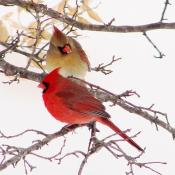 Unlike many other songbirds in North America, both the male and female cardinals can sing. Usually, only a male songbird is capable of singing. When a female cardinal sings from the nest, it usually means she’s telling the male she needs more food. Cardinals mate for life. A group of cardinals has many collective nouns, including a “college”, “conclave”, “deck”, “radiance”, and “Vatican” of cardinals.
Unlike many other songbirds in North America, both the male and female cardinals can sing. Usually, only a male songbird is capable of singing. When a female cardinal sings from the nest, it usually means she’s telling the male she needs more food. Cardinals mate for life. A group of cardinals has many collective nouns, including a “college”, “conclave”, “deck”, “radiance”, and “Vatican” of cardinals.
The cardinal is the mascot of prominent sports teams and schools, including the St. Louis Cardinals (baseball) and Arizona Cardinals (football); it is the state bird of seven states, more than any other bird: Illinois, Indiana, Kentucky, North Carolina, Ohio, Virginia, West Virginia
Flower: Dogwood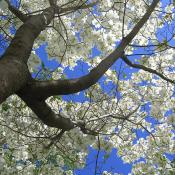 Virginia – American dogwood – The term “dogwood winter”, in colloquial use in the American Southeast, is sometimes used to describe a cold snap in spring, presumably because farmers believed it was not safe to plant their crops until after the dogwoods blossomed. According to legend, Jesus Christ was crucified on a dogwood cross, after which God declared that dogwoods would again never grow tall enough for the construction of crucifixion crosses
Virginia – American dogwood – The term “dogwood winter”, in colloquial use in the American Southeast, is sometimes used to describe a cold snap in spring, presumably because farmers believed it was not safe to plant their crops until after the dogwoods blossomed. According to legend, Jesus Christ was crucified on a dogwood cross, after which God declared that dogwoods would again never grow tall enough for the construction of crucifixion crosses
One of the most interesting dogwood tree facts is that their roots are used to make dyes. There are several species of dogwood, the roots of which provide different color dyes. Specifically, dogwood roots provide red, black and yellow dyes. Additional colors can be created by mixing dogwood root with other plants that provide dyes. The wood from dogwood trees was previously used in the construction of wheels, weaving shuttles, hay forks and machine bearings. This is largely due to the fact that wood from the dogwood tree resists splitting, and wears smoothly and evenly. The wood is strong, dense, durable, and shock resistant. For these reasons, this particular wood is still used in the manufacture of items such as golf club heads, walking canes, tool handles, spindles and mallet heads. Quinine
Almost all parts of dogwood trees can be used for medicinal purposes: the bark, roots, berries, twigs, leaves and flowers. Native Americans used the root of dogwood trees to treat malaria. The inner bark of the roots contains the alkaloid known as cornin. Other ailments that have been treated with dogwood include insomnia, asthma, fevers, muscular problems, whooping cough, toothache and even canine mange. When supplies of quinine ran low during the Civil War, dogwood extract was used as a substitute.
Tree: Dogwood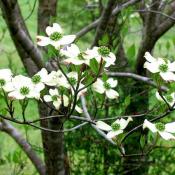
This species has in the past been used in the production of inks, scarlet dyes, and as a quinine substitute. The hard, dense wood has been used for products such as golf club heads, mallets, wooden rake teeth, tool handles, jeweler’s boxes and butcher’s blocks. It is the state tree and flower of Virginia, the state tree of Missouri, and state flower of North Carolina. It was used to treat dogs with mange, which may be how it got its name. The red berries are edible, but do not taste good.
In 1915, forty dogwood saplings were donated by U.S. to Japan in the 1912-15 exchange of flowers between Tokyo and Washington, D.C. While the cherry trees survived the ensuing sour relations of these two countries and are the main feature of the National Cherry Blossom Festival, all dogwood trees in Tokyo died except the one that had been planted in an agriculture high school. In 2012, the United States sent 3,000 dogwood saplings to Japan to commemorate the 100 year anniversary of the Washington D.C. cherry trees given as a gift to the U.S. by Japan in 1912.
State Quarter
From theus50.com
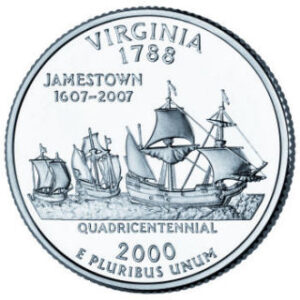
The Virginia quarter honors Jamestown, Virginia, our nation’s first permanent English settlement. Jamestown turned 400 years old in 2007. The selected design features the three ships, Susan Constant, Godspeed, and Discovery. These ships brought the first English settlers to Jamestown.
On April 10, 1606, King James I of England chartered the Virginia Company to encourage colonization in the New World. The first expedition, consisting of the three ships depicted on the quarter, embarked from London on December 20, 1606. On May 12, 1607, they landed on a small island along the James River nearly 60 miles from the mouth of the Chesapeake Bay. It was here the original settlers (104 men and boys) established the first permanent English settlement called Jamestown, in honor of King James I.
Capital: Richmond
Nickname: Old Dominion, “The Birthplace of a Nation”, Mother of States.
Motto: Thus always to tyrants
Virginia Facts and Trivia
Virginia was named for England’s “Virgin Queen,” Elizabeth I.
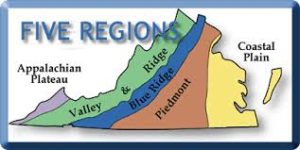 Travel the state from west to east, and you’ll pass through five different geographical areas.
Travel the state from west to east, and you’ll pass through five different geographical areas.
- Farthest west is the Appalachian Plateau, which is covered in forests, winding rivers, and flat-topped rock.
- Continue east, and you’ll cross the Appalachian Ridge and Valley, which is full of caverns, sinkholes, and natural bridges. It’s also where you’ll find Shenandoah National Park.
- Farther east is the Blue Ridge, a steep part of the Appalachian Mountains with craggy peaks and deep ravines. It includes Virginia’s highest peak, Mount Rogers.
- Next is the Piedmont, a plain that spreads across most of central Virginia.
- The Piedmont leads to the Atlantic Coastal Plain, a lowland with swamps and salt marshes that stretches to the ocean.
Virginia is very green. The state’s department of forestry reports that 62 percent of the state is forested.
In 1606, the Virginia Company of London was granted a charter to start a colony in Virginia. They gathered a group of settlers and set sail on three ships named the Susan Constant, the Discovery, and the Godspeed. Upon reaching Virginia they founded the settlement of Jamestown on May 13, 1607.
The first Thanksgiving in North America was held in Virginia in 1619.
Despite the early struggles, more and more settlers arrived in Virginia. Tobacco became an important crop and large tobacco plantations formed throughout Virginia. In order to work the land, slaves were brought in from Africa.
In 1624, Virginia was made a crown colony of Britain.
1676 – Bacon’s Rebellion occurs and the city of Jamestown is burned.
Per Wikipedia:
The immediate cause of the rebellion was Governor Berkeley’s refusal to retaliate for a series of Native American attacks on frontier settlements. In addition, many colonists wished to attack and claim Native American frontier land westward, but they were denied permission by Gov. Berkeley. Many of these colonists were former indentured servants whose contracts had terminated and who were now free, looking for land.
The capital city was moved from Jamestown to Williamsburg in 1698.
When the Revolutionary War broke out in 1775, Virginia was quick to send troops and organize a militia to fight the British. Some of the main leaders of the revolution, such as General George Washington who led the Continental Army and Thomas Jefferson who wrote the Declaration of Independence, were from Virginia.
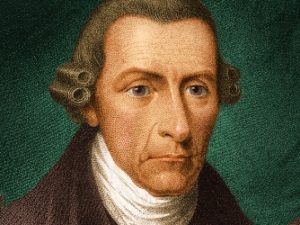 It was Virginia’s Patrick Henry who said “Give me liberty, or give me death!” (Full speech may be found at Avalon Project
It was Virginia’s Patrick Henry who said “Give me liberty, or give me death!” (Full speech may be found at Avalon Project
It was at the Battle of Yorktown where the British finally surrendered.
After the war, Virginia voted to ratify the U.S. Constitution and became the 10th state on June 25, 1788.
1789 – Virginian George Washington is elected the first President of the United States.
Arlington County was originally part of the ten-mile square parcel of land surveyed in 1791 to be part of Washington, DC. The U.S. Congress returned that portion of the land to the “Commonwealth of Virginia” following a referendum among its citizens. It was given back to the state in the 1840s, in part because Alexandria was a major slave market and some of its residents feared that slavery would be outlawed in the capital.
In 1792, nine counties known as the Kentucky District of Virginia entered the union as the state of Kentucky.
In 1801 Thomas Jefferson was elected the third President of the United States.
1859 – Abolitionist John Brown led a raid on the federal armory at Harper’s Ferry hoping to arm the slaves in a revolt.
Before the beginning of the Civil War, Virginia, Georgia, Mississippi, Alabama, and South Carolina each had more than 400,000 slaves.
When Abraham Lincoln was elected president, several southern states seceded from the Union and formed the Confederate States. At first, Virginia wanted to remain loyal to the Union, but they did not want to fight their fellow southern states. When fighting broke out at Fort Sumter in 1861, Virginia seceded from the Union and joined the Confederacy.
West Virginia broke away from Virginia and formed its own state in 1863.
General Thomas Jackson got his nickname “Stonewall” in Manassas. The site of 2 major Civil War Battles.
Virginia was home to the Confederate capital, Richmond, and adjacent to Washington, D.C., making it an important target for Union forces. Over the course of the war, 26 major battles and 2000 total military engagements took place in the state, over half of all the battles of the civil war.
On March 9, 1862 at Hampton Roads, Virginia, the USS Monitor and the CSS Virginia (formerly the USS Merrimac) met in one of the most famous naval engagements in US history. Their battle, the first of its kind between metal armored vessels, changed the nature of naval warfare.
The Arlington National Cemetery, one of America’s most renowned military cemeteries, was originally built in the early 19th century as a mansion by George Washington’s adopted grandson, George Washington Parke Custis. Robert E. Lee, who married Custis’ daughter, Mary Anna, lived in Arlington House at various periods until 1861, when Virginia seceded from the Union and the couple vacated the estate. On June 15, 1864, the property was established as a military cemetery.
The capital of the Confederacy was moved to Richmond, Virginia. As a result, much of the fighting during the Civil War took place in Virginia. Some of the major Civil War battles that took place in Virginia included the Battle of Spotsylvania Court House, the Battle of Chancellorsville, the Second Battle of Bull Run, and the Battle of Appomattox Court House. It was on April 9, 1865 at Appomattox that General Robert E. Lee of the Confederate Army surrendered to General Ulysses S. Grant and the Civil War came to an end.
1870 – Virginia is readmitted to the Union.
The Virginia General Assembly is the oldest continuous law-making body in the New World. And it prohibits the governors from serving two consecutive terms.
About 1/2 of all the people in the United States live within a 500 mile radius of the Capital of Virginia, Richmond.
Virginia has had 3 capital cities: Jamestown, Williamsburg, and Richmond. The capital city was moved from Jamestown to Williamsburg in 1698. Richmond became the capital city in 1780 at the urging of Governor Thomas Jefferson, who feared that Williamsburg’s coastal location would make it vulnerable to British attack.
Yes, Williamsburg, Virginia, is home to a world-famous historic district. But it’s also the location of the all-important Presidential Pet Museum. There, you can learn about George Washington’s beloved horse, Nelson; James Buchanan’s herd of elephants; and Calvin Coolidge’s lion cubs.
The Pentagon building in Arlington is the largest office building in the world. The Pentagon has three times the floor space as the Empire State Building.
The Pentagon building, headquarters of the U.S. Department of Defense, was opened in Arlington in 1943. In 2001, the Pentagon was crashed into by a hijacked passenger jet as part of the 9-11 terrorist attacks.
In Virginia more people work for the United States government than any other industry. About 1/4 of Virginia’s workers.
Virginia has no major professional sports teams.
From Readers Digest/difficult to pronounce towns,
McGaheysville, Virginia, is an unincorporated community located in Rockingham County. Just looking at it makes us cringe with the mispronunciation-shivers. That said, it makes us think of Matthew McConaughey, which is always kind of nice. Here’s how you pronounce it: Muh-GAK-eez-vil, which is not even close to how it’s spelled.
Presidents
Eight United States Presidents were born in Virginia, more than any other state:
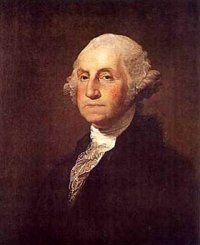 George Washington,
George Washington, 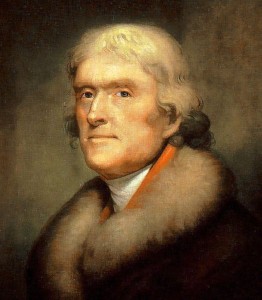 Thomas Jefferson,
Thomas Jefferson, 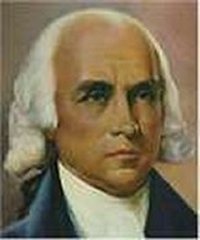 James Madison,
James Madison, 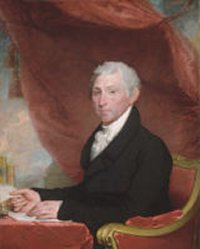 James Monroe,
James Monroe, 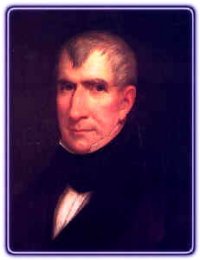 William Harrison,
William Harrison, 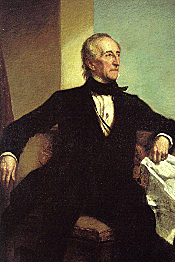 John Tyler,
John Tyler, 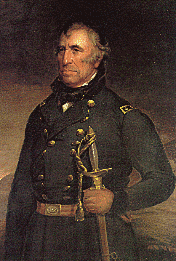 Zachary Taylor, and
Zachary Taylor, and 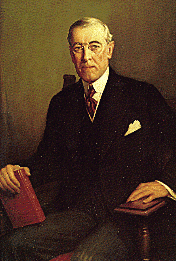 Woodrow Wilson.
Woodrow Wilson.
Six Presidents’ wives were born in Virginia: Martha Washington, Martha Jefferson, Rachel Jackson, Letitia Tyler, Ellen Arthur, Edith Wilson.
Seven Presidents are buried in Virginia: Washington, Jefferson, Madison, Monroe, Tyler, Taft and Kennedy.
These presidents’ homes are open to visitors:
- Washington’s home, Mount Vernon, in Fairfax County, on the banks of the Potomac River ;
- Jefferson’s home, Monticello, in Albemarle County, in the Piedmont Region;
- Madison’s home, Montpelier, in Orange County, also in the Piedmont Region;
- Monroe’s home, Highland, in Albemarle County, adjacent to Montpelier;
- William Harrison’s birthplace, Berkeley Plantation on the banks of the James River;
- and Tyler’s home, Sherwood Forest Plantation, on the north bank of the James River.
From the post-Civil War Reconstruction period through 1948, Virginians almost always sided with the Democratic Party in elections. However, from 1952 through 2004, Virginia was reliably Republican (except for the landslide of Lyndon Johnson over Barry Goldwater in 1964). What changed? In the early 1950s, Virginia politics was controlled by Democratic Senator Harry F. Byrd, Sr., and his political machine. For the 1952 cycle, Byrd announced he would not be endorsing a candidate, saying “Silence is Golden.” People knew this meant that it would be okay to vote for the Republican Dwight Eisenhower.
Shifting demographics, including more rapid population growth around Washington D.C., have made the state a battleground in recent elections, perhaps one that now leans Democratic again. Barack Obama won here twice and Hillary Clinton made it three in a row for Democrats, winning by about 5.5% over Donald Trump in 2016.
Virginia is considered a moderately red state (Republican) in presidential elections.
Regional differences play a large part in Virginia politics. Rural southern and western areas moved to support the Republican Party in response to its “southern strategy”, while urban and growing suburban areas, including much of Northern Virginia and recently, Richmond form the Democratic Party base. Democratic support also persists in union-influenced Roanoke in Southwest Virginia, college towns such as Charlottesville and Blacksburg, and the southeastern Black Belt Region.
Strange Laws:
Since 1986, amusement parks have determined the state’s academic calendar, prohibiting public schools in the state from opening before Labor Day.
There is a state law prohibiting “corrupt practices of bribery by any person other than candidates.
You may not engage in business on Sundays, with the exception of almost every industry.
Driving while not wearing shoes is prohibited.
Police radar detectors are illegal. Police are not allowed to use speed radar detectors.
Citizens must honk their horn while passing other cars.
Children over the age of 13 are not to go trick-or-treating on Halloween.
It is illegal to tickle women.
No animal may be hunted for on Sunday with the exception of raccoons, which may be hunted until 2:00 AM.
Virginians cannot spit on seagulls.
It is Illegal to Shine a Light on a Poultry House or Similar Structure at night in a way which might cause the animals to panic or become injured.
In Prince William County, it is illegal to keep a skunk as a pet.
People, not including Presidents:
- Richard Arlen, actor
- Arthur Ashe, tennis player
 Pearl Bailey, singer
Pearl Bailey, singer- Warren Beatty, actor
- Richard E. Byrd, polar explorer
- Willa Cather, author
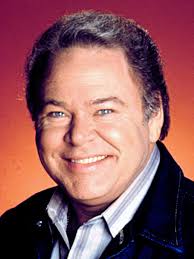 Roy Clark, country music artist
Roy Clark, country music artist- William Clark, explorer
- Henry Clay, statesman
- Joseph Cotten, actor
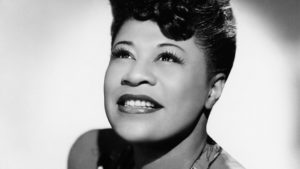 Ella Fitzgerald, jazz singer
Ella Fitzgerald, jazz singer- Patrick Henry, statesman
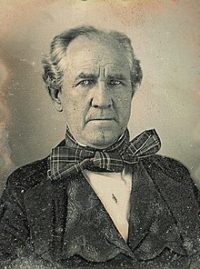 Sam Houston, political leader
Sam Houston, political leader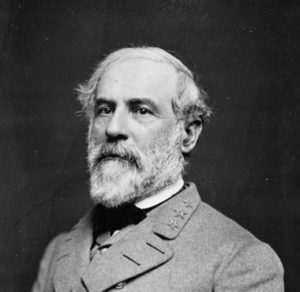 Robert E. Lee, Confederate general
Robert E. Lee, Confederate general- Meriwether Lewis, explorer
- Shirley MacLaine, actress
- John Marshall, jurist
- Cyrus Hall McCormick, inventor
- John Payne, actor
- Walter Reed, army surgeon
- Bill Bojangles Robinson, dancer
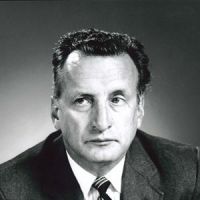 George C. Scott, actor
George C. Scott, actor- Sam Snead, golfer
- James Jeb Stuart, Confederate army officer
- Nat Turner, leader of slave uprising
- Booker T. Washington, educator
- Tom Wolfe, journalist
Credits:
See ducksters.com
See 50 states.com
See mental floss.com
See national geographic.com
See tingenwilliams.com
See ign.com
See coverhound.com
